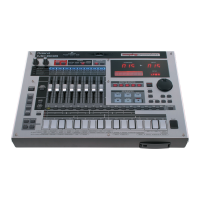51
Patch editing parameters
LFO (Low Frequency Oscillator) creates cyclic changes. Each tone has two LFOs, and these can be used to apply change to pitch, filter
cutoff frequency, amp level, and pan.
Using the LFOs
An LFO applied to pitch creates vibrato, applied to filter cutoff frequency creates a wah effect, and applied to amp level creates tremolo. When
LFO is applied to pan, a distinctive auto-pan effect is produced.
LFO settings can also be used to do things such as cyclically exchanging two tones. For example, to cyclically exchange tones 1 and 2, specify the
same LFO effect for each, and set the LFO depth to opposite polarities (+/-) for the amp level.
* The parameters of LFO 1 and 2 are the same.
LFO
Parameter
Value Description
LFO1(2) Waveform
SIN, TRI,
SAWU,
SAWD,
SQR, RND,
BD-U,
BD-D, TRP,
S&H, CHS,
XSIN,
TWM, STRS,
VSIN,
M001–M113
LFO waveform
SIN:
sine wave
TRI:
triangle wave
SAWU:
sawtooth wave
SAW-D:
sawtooth wave (inverted)
SQR:
square wave
RND:
random wave
BD-U:
a waveform that lets the LFO output waveform rise to the reference level and holds it there
BD-D:
a waveform that lets the LFO output waveform fall to the reference level and holds it there
TRP:
trapezoidal wave
S&H:
sample and hold wave (LFO value will change once each period)
CHS:
chaos wave
XSIN:
sine wave that reverses between positive and negative at an extremely short interval
TWM:
modified triangle wave
STRS:
stair-step wave
VSIN:
modified sine wave suitable for vibrato
M001–M113:
the waveform will change continuously from a sine wave to sample & hold
* If you select “BD-U” or “BD-D,” set the Key Trigger (p. 51) parameter to “ON.” There will be no effect
if you set it to “OFF.”
LFO1(2) Rate 0–127, note Speed of the LFO cycle
* The chaos waveform has no cycle. If you select the chaos waveform, the rate setting will be ignored.
Offset
(LFO Offset)
-100– +100 Offset level of the LFO waveform
Adjusts the waveform upward or downward.
Rate Detune
(LFO Rate Detune)
0–127 Amount by which the LFO rate will be changed
Delay Time
(LFO Delay Time)
0–127 Time from when you press (or release) a pad until the LFO amplitude begins to change
Delay Time KF
(LFO Delay Keyfol-
low)
-100– +100 Amount by which the Delay Time will be affected by the pad you press
Modifies the Delay Time parameter according to the pad you press, relative to C4 (middle C). Specify
a positive (+) value if you want the LFO effect to be applied more quickly as you press higher notes,
or specify a negative (-) value if you want a greater delay to occur before the effect is applied. Higher
settings will produce a correspondingly greater change.
Fade Mode
(LFO Fade Mode)
On<, On>,
Off<, Off>
How the LFO effect is applied
On< (ON-IN):
The effect will be applied gradually after you press the pad.
On> (ON-OUT):
The effect will be applied when you press the pad, and will gradually disappear.
Off< (OFF-IN):
The effect will be applied gradually after you release the pad.
Off> (OFF-OUT):
The effect will be applied as long as you hold down the pad, and will gradually
disappear when you release the pad.
Fade Time
(LFO Fade Time)
0–127 Rise (or decay) time for the LFO effect
Key Trigger
(LFO Key Trigger)
OFF, ON Selection for whether the beginning of the LFO cycle will be aligned to the timing at which you press a
pad (ON), or will not be aligned (OFF)
C4C3C2C1 C5 C6 C7
0
Key
Time
+50
+100
-50
-100
MC-808_Slist_e.book 51 ページ 2007年9月7日 金曜日 午前11時11分

